Feverfew (Tanacetum parthenium) Non-Native
Feverfew (Tanacetum parthenium)
Parts used: aerial portions
Medicinal uses: May be used to lower temperature and cool the body. Historically the plant has been used to induce menstruation and can be used to aid difficult births by aiding the expulsion of the placenta. In small quantities it can be used to prevent migraines. It is useful for migraines associated with menstruation and for headaches. The herb can also help arthritic and rheumatic pain (Chevallier 140).
Additional uses: The dried flowers can be used in flower arrangements. The fresh leaves and stems produce a greenish yellow dye in wool mordanted with chrome (Kowalchik 193).
Cautions: Eating fresh leaves may cause canker sores. Do not take feverfew if taking warfarin or other blood thinning drugs. Do not take if pregnant or breastfeeding (Chevallier 140).
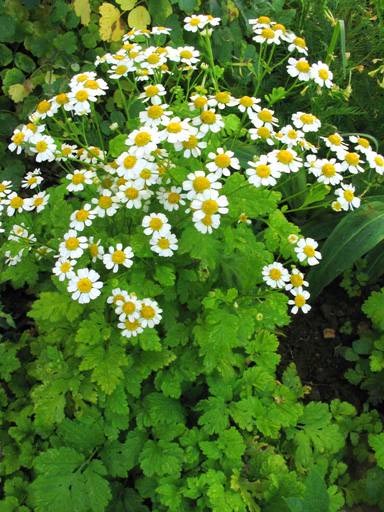
Pacific Northwest Medicinal Plant Guide (Check out all plants growing in Tryon Farm's medicinal garden!)
- Login to post comments



Evening primrose (Oenothera biennis) Native
Evening primrose (Oenothera biennis)
Parts used: leaves, stem bark, flowers, seed oil
Medicinal uses: The flowers, leaves, and stem bark have astringent and sedative properties. All can be used to treat whooping cough. It can also be taken for digestive problems and asthma, and used as a poultice to ease the discomfort of rheumatic disorders. The oil, when applied externally can be used for eczema, other itchy skin conditions, and breast tenderness. Taken internally the oil lowers blood pressure and prevents the clot of platelets. The oil is commonly taken for premenstrual problems including tension and abdominal bloating.
Cautions: Do not take the oil if suffering from epilepsy (Chevallier 240).
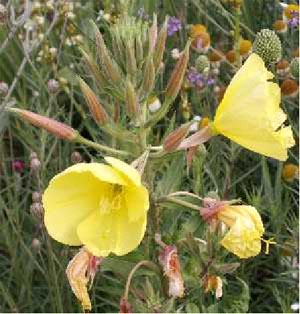
Pacific Northwest Medicinal Plant Guide (Check out all plants growing in Tryon Farm's medicinal garden!)
- Login to post comments



Eucalyptus (Eucalyptus spp.) Non-Native
Eucalyptus (Eucalyptus spp.)
Parts used: leaves
Medicinal uses: A traditional Aboriginal remedy for infections and fevers. The herb is an antiseptic and is very helpful for colds, flu, and sore throats. A strong expectorant which makes it useful for chest infections including bronchitis and pneumonia. The diluted essential oil, applied to the skin as a chest or sinus rub, has a warming and slightly anesthetic effect, helping to relieve respiratory infections. This can also be experienced by using an infusion or tincture as a gargle. The diluted essential oil can also be used for pain relief. It can be applied to the affected area to relieve rheumatic joints as well as neuralgia and some bacterial skin infections (Chevallier 98).
Additional uses: The dried leaves and small branches can be used in potpourris as well as in flower arrangements (Kowalchik 186).
Cautions: Do not give to small children or infants (Chevallier 98).
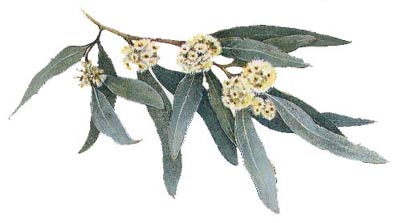
Pacific Northwest Medicinal Plant Guide (Check out all plants growing in Tryon Farm's medicinal garden!)
- Login to post comments



Elecampane (Inula helenium) Non-Native
Elecampane (Inula helenium)
Parts used: root, rhizome
Medicinal uses: Dried roots and rhizomes used as an expectorant for treatment of coughs and bronchial catarrh. Traditionally used as a bitter tonic, stomachic carminative, cholagogue, diaphoretic, and diuretic. Root used against several intestinal parasites and for infections of urinary tract. Externally used as antiseptic to treat skin conditions.
Additional uses: Elecampane root has been used in the past as a flavoring for sweets. The root itself can also be candied as a sweet itself (Kowalchik 183).
Cautions: Can cause skin reactions. Do not take internally if pregnant or breastfeeding.
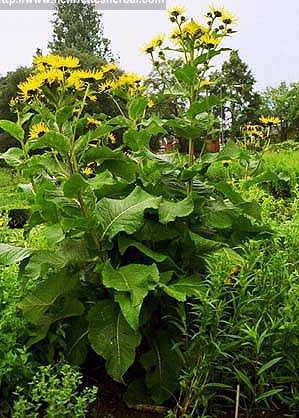
Pacific Northwest Medicinal Plant Guide (Check out all plants growing in Tryon Farm's medicinal garden!)
- Login to post comments



Elderberry (Sambucus spp.) Native & Non-Native
Elderberry (Sambucus spp.)
There are native and invasive, non-native speicies of Elderberry in Portland
Parts used: flowering tops, berries
Medicinal and other uses: Flowers used to treat colds and catarrh of the upper respiratory tract and hay fever. Dried fruits or fresh juice are used as an analgesic, diuretic, laxative and diaphoretic in cases of feverish catarrhal conditions. Flowers used in herbal teas and remedies, and for light alcoholic beverages. Berries are used as a natural coloring agent in food products. Yellow and violet dyes can be made from the leaves and berries.
Cautions: It is best to eat cooked ripe berries rather than raw. The roots, stems, and leaves are said to contain cyanogenic glucosides which are substances that release cyanide, care should be taken when ingesting (Kowalchik 178-9).
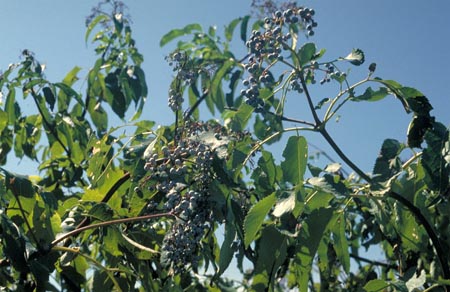
Pacific Northwest Medicinal Plant Guide (Check out all plants growing in Tryon Farm's medicinal garden!)
- Login to post comments



Echinacea (Echinacea spp.) Central American Native
Echinacea (Echinacea spp.)
Parts used: root and flower
Medicinal uses: Juice or dry herb used to treat colds and infections of respiratory tract, urinary tract, and to externally treat wounds, ulcers, and skin inflammations.
Cautions: High doses can cause nausea (Chevallier 94).
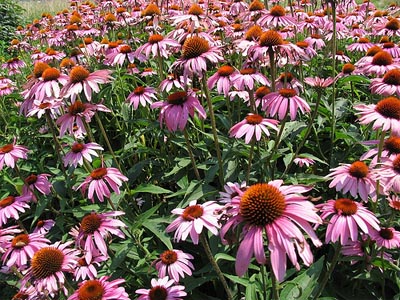
Pacific Northwest Medicinal Plant Guide (Check out all plants growing in Tryon Farm's medicinal garden!)
- Login to post comments



Dogwood (Cornus spp.) some varieties Native
Dogwood (Cornus spp.) some varieties
Parts used: root bark
Other uses: The root bark of Cornus spp. has been used in traditional fabric dyeing. Red is the most typical color produced by Dogwood.
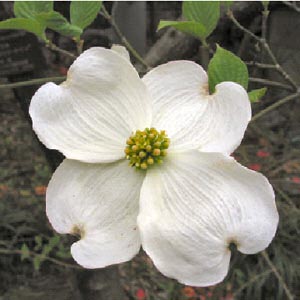
Pacific Northwest Medicinal Plant Guide (Check out all plants growing in Tryon Farm's medicinal garden!)
- Login to post comments



Dandelion (Taraxacum officinale) Native
Dandelion (Taraxacum officinale)
Parts used: leaves, root, flower
Medicinal uses: Leaf is used as a diuretic and to treat high blood pressure by reducing the volume of fluid in the body. The root is a very effective detoxifying herb. It works principally on the liver and gallbladder to help remove waste products, it also stimulates the kidneys to remove toxins in the urine. The root and leaf can also be used to prevent gallstones while the leaf may be used to help dissolve those that have already formed. It is beneficial for many conditions, including constipation, skin problems such as acne, eczema, and psoriasis, and arthritic conditions, including osteoarthritis, and gout (Chevallier 141).
Additional uses: The leaves and root of dandelion are edible and can be prepared in a variety of ways. The leaves are often eaten raw or cooked while the root can be added to soups or stews as well as stir-fries. Roasting is another common preparation for dandelion root and is often used as a substitute for coffee. The flowers can be made into wine. The flowers can also be used to make a yellow dye while the whole plant can be used to make a magenta dye (Kowalchik 141-2).

Pacific Northwest Medicinal Plant Guide (Check out all plants growing in Tryon Farm's medicinal garden!)
Cautions: None known (Chevallier 141).
- Login to post comments



Cramp bark (Viburnum opulus) Native to Easter N. America
Cramp bark (Viburnum opulus)
Parts used: bark
Medicinal uses: Effective at relieving tense muscle, whether in smooth muscle or skeletal muscles. It may be taken internally or applied topically to ease muscle tension. This plant also treats symptoms arising from excess muscle tension, including breathing difficulties in asthma and menstrual pain caused by excessive contraction of the uterus. The herb also relieves constipation, colic, and irritable bowel syndrome, as well as the physical symptoms of nervous tension. In some cases of arthritis where joint weakness and pain have caused muscles to contract significantly, Crampbark can bring about significant relief. Crampbark is also commonly used in treatments for high blood pressure and other circulatory conditions.
Cautions: None known (Chevallier 150).
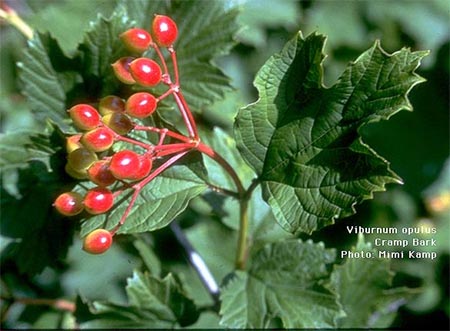
Pacific Northwest Medicinal Plant Guide (Check out all plants growing in Tryon Farm's medicinal garden!)
- Login to post comments



Comfrey (Symphytum officinale) Non-Native
Comfrey (Symphytum officinale)
Parts used: aerial portion, root
Medicinal uses: Comfrey has been used in the past to treat stomach ulcers, irritable bowel syndrome, and a range of respiratory conditions, including bronchitis and pleurisy. Promotes the healing of bruises, sprains, fractures, and broken bones. It encourages ligaments and bones to knit firmly together firmly. A comfrey compress applied immediately to a sprained ankle can significantly reduce the severity of the injury. The combinations of tannins and mucilage helps to soothe bruises and scrapes. Comfrey oil or ointment can be used to treat acne and boils and to relieve psoriasis. It is also valuable in the treatment of scars (Chevallier 137).
Additional uses: The leaves of comfrey produce a brown dye in wool mordanted with iron (Kowalchik 105).
Cautions: Pyrrolizidine alkaloids have been found to be highly toxic in the liver. The substance has been found in higher concentrations of the root than in any other part of the plant. Many recommend that this plant not be taken internally except under professional supervision. It should also not be applied externally to open or dirty wounds as the healing process can occur quickly trapping debris and pus. Do not use if pregnant or nursing (Chevallier 137).
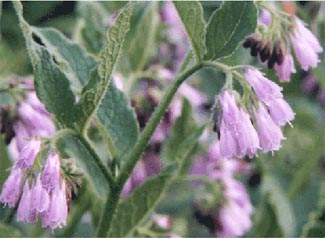
Pacific Northwest Medicinal Plant Guide (Check out all plants growing in Tryon Farm's medicinal garden!)
- Login to post comments



Feedback and participation welcome! Please send bug reports to web@tryonfarm.org







